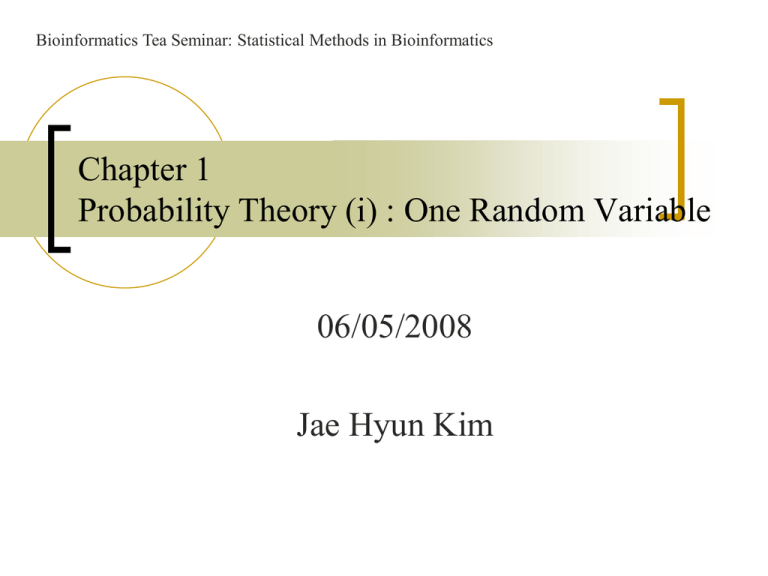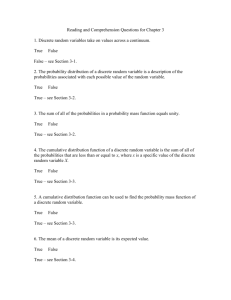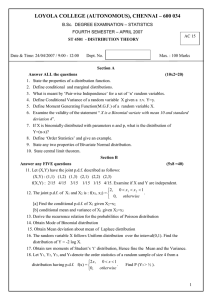06/05/2008 Jae Hyun Kim Chapter 1 Probability Theory (i) : One Random Variable
advertisement

Bioinformatics Tea Seminar: Statistical Methods in Bioinformatics
Chapter 1
Probability Theory (i) : One Random Variable
06/05/2008
Jae Hyun Kim
Content
Discrete Random Variable
Discrete Probability Distributions
Probability Generating Functions
Continuous Random Variable
Probability Density Functions
Moment Generating Functions
jaekim@ku.edu
2
Discrete Random Variable
Discrete Random Variable
Numerical quantity that, in some experiment (Sample
Space) that involves some degree of randomness, takes
one value from some discrete set of possible values
(EVENT)
Sample Space
Set of all outcomes of an experiment (or observation)
For Example,
Flip a coin { H,T }
Toss a die {1,2,3,4,5,6}
Sum of two dice { 2,3,…,12 }
Event
Any subset of outcome
jaekim@ku.edu
3
Discrete Probability Distributions
The probability distribution
Set of values that this random variable can take, together
with their associated probabilities
Example,
Y = total number of heads when flip a coin twice
Probability Distribution Function
Cumulative Distribution Function
jaekim@ku.edu
4
One Bernoulli Trial
A Bernoulli Trial
Single trial with two possible outcomes
“success” or “failure”
Probability of success = p
jaekim@ku.edu
5
The Binomial Distribution
The Binomial Random Variable
The number of success in a fixed number of n independent
Bernoulli trials with the same probability of success for
each trial
Requirements
Each trial must result in one of two possible outcomes
The various trials must be independent
The probability of success must be the same on all trials
The number n of trials must be fixed in advance
jaekim@ku.edu
6
Bernoulli Trail and Binomial Distribution
Comments
Single Bernoulli Trial = special case (n=1) of
Binomial Distribution
Probability p is often an unknown parameter
There is no simple formula for the cumulative
distribution function for the binomial
distribution
There is no unique “binomial distribution,” but
rather a family of distributions indexed by n
and p
jaekim@ku.edu
7
The Hypergeometric Distribution
Hypergeometric Distribution
N objects ( n red, N-n white )
m objects are taken at random, without replacement
Y = number of red objects taken
Biological example
N lab mice ( n male, N-n female )
m Mutations
The number Y of mutant males: hypergeometric
distribution
jaekim@ku.edu
8
The Uniform/Geometric Distribution
The Uniform Distribution
Same values over the range
The Geometric Distribution
Number of Y Bernoulli trials before but not including the
first failure
Cumulative distribution function
jaekim@ku.edu
9
The Poisson Distribution
The Poisson Distribution
Event occurs randomly in time/space
For example,
The time between phone calls
Approximation of Binomial Distribution
When
n is large
p is small
np is moderate
Binomial (n, p, x ) = Poisson (np, x) ( = np)
jaekim@ku.edu
10
Mean
Mean / Expected Value
Expected Value of g(y)
Example
Linearity Property
In general,
jaekim@ku.edu
11
Variance
Definition
jaekim@ku.edu
12
Summary
jaekim@ku.edu
13
General Moments
Moment
r th moment of the probability distribution about
zero
Mean : First moment (r = 1)
r th moment about mean
Variance : r = 2
jaekim@ku.edu
14
Probability-Generating Function
PGF
Used to derive moments
Mean
Variance
If two r.v. X and Y have identical probability
generating functions, they are identically
distributed
jaekim@ku.edu
15
Continuous Random Variable
Probability density function f(x)
Probability
Cumulative Distribution Function
jaekim@ku.edu
16
Mean and Variance
Mean
Variance
Mean value of the function g(X)
jaekim@ku.edu
17
Chebyshev’s Inequality
Chebyshev’s Inequality
Proof
jaekim@ku.edu
18
The Uniform Distribution
Pdf
Mean & Variance
jaekim@ku.edu
19
The Normal Distribution
Pdf
Mean , Variance 2
jaekim@ku.edu
20
Approximation
Normal Approximation to Binomial
Condition
n is large
Binomial (n,p,x) = Normal (=np, 2=np(1-p), x)
Continuity Correction
Normal Approximation to Poisson
Condition
is large
Poisson (,x) = Normal(=, 2=, x)
jaekim@ku.edu
21
The Exponential Distribution
Pdf
Cdf
Mean 1/, Variance 1/2
jaekim@ku.edu
22
The Gamma Distribution
Pdf
Mean and Variance
jaekim@ku.edu
23
The Moment-Generating Function
Definition
Useful to derive
m’(0) = E[X], m’’(0) = E[X2], m(n)(0) = E[Xn]
mgf m(t) = pgf P(et)
jaekim@ku.edu
24
Conditional Probability
Conditional Probability
Bayes’ Formula
Independence
Memoryless Property
jaekim@ku.edu
25
Entropy
Definition
can be considered as function of PY(y)
a measure of how close to uniform that distribution
is, and thus, in a sense, of the unpredictability of
any observed value of a random variable having that
distribution.
Entropy vs Variance
measure in some sense the uncertainty of the value
of a random variable having that distribution
Entropy : Function of pdf
Variance : depends on sample values
jaekim@ku.edu
26






